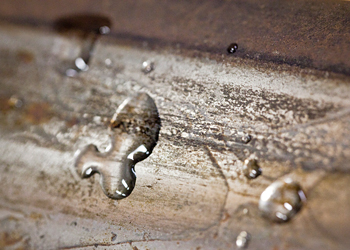Adhesion in the wheel rail contact

Background
The wheel rail contact operates with the limitations imposed by the friction existing between steel surfaces. When exerting traction a friction coefficient no greater than roughly 0.2-0.4 can be assumed and for safety braking duty demands no more than 0.1. These rules impose fundamental boundaries on railway operation. Poor adhesion in braking is a safety issue as it leads to extended stopping distances. In traction, however, it is also a performance issue.
If a train experiences poor adhesion when pulling away from a station and a delay is enforced the train operator will incur costs. Similar delays will occur if a train passes over areas of poor adhesion while in service. Fallen leaves can disrupt rail services all over Europe. A mature tree has between 10000 and 50000 leaves. There are estimations that thousands of tonnes of leaves fall onto railway lines every year. The leaves are usually swept onto the track by the slipstream of passing trains. While conditions leading to poor adhesion have been well investigated, methods for addressing the problems have not.
Purpose
The purpose of this project is firstly to develop a test method where friction modifiers can be evaluated in contact conditions and an environment that correspond to the wheel rail contact. Secondly, the research aims to develop new environmentally friendly friction modifiers and, furthermore, to develop adhesion models for the railway wheel rail contact including contaminants.
Publications
Olofsson U., and Sundvall K., Influence of leaf, humidity, and applied lubrication on friction in the wheel-rail contact: pin-on-disc experiments, Journal of rail and rapid transit Volume: 218 (2004) 235-242
Olofsson U., A multilayer model of low adhesion between railway wheel and rail, Journal of rail and rapid transit, vol.221 (2007) 385-389
U. Olofsson, K. Sundvall: Influence of leaf, humidity and applied lubrication on friction in the wheel-rail contact: pin-on-disc experiments, IMechE, Part F: J. Rail and Rapid Transit 281 (2004)
Y. Zhu, U. Olofsson, A. Söderberg: Adhesion modeling in the wheel–rail contact under dry and lubricated conditions using measured 3d surfaces, Submitted to Trib. Int
Y. Zhu, U. Olofsson, K. Persson: Investigation of factors influencing wheel–rail adhesion using a mini traction machine, Submitted to Wear

